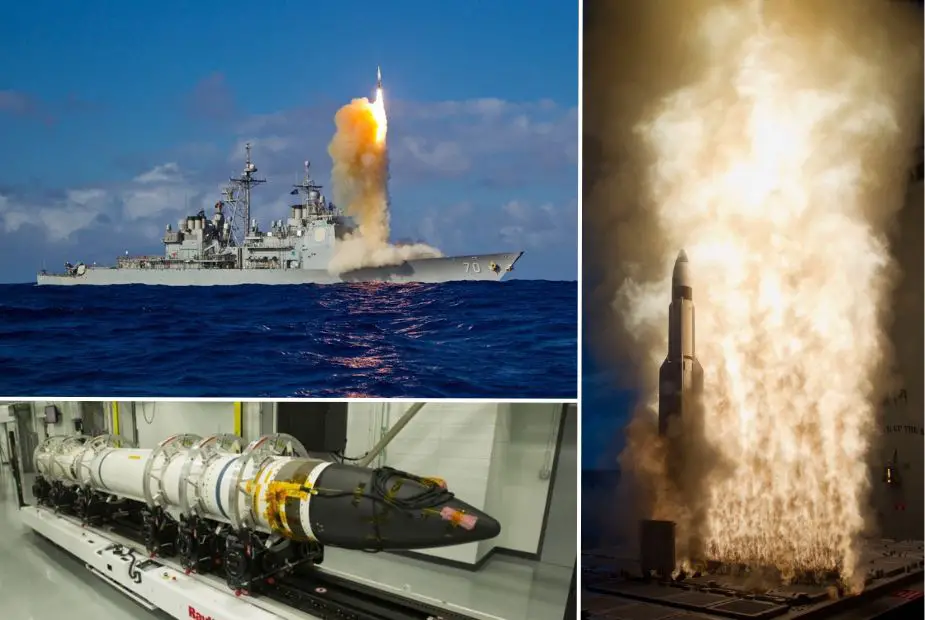Breaking news
First Combat Use of US SM-3 Interceptor Missiles Against Iranian Ballistic Missiles.
On April 14, 2024, Arleigh Burke-class missile destroyers deployed Standard Missile-3 (SM-3) interceptors for the first time to counter an Iranian ballistic missile attack on Israel. This operation, conducted in the Eastern Mediterranean, involved the USS Arleigh Burke (DDG-51) and USS Carney (DDG-64), which fired between four and seven SM-3s to intercept the Iranian ballistic missiles. This marks the first combat use of the SM-3 interceptors, as confirmed by defense sector sources.
Follow Navy Recognition on Google News at this link
 A Standard Missile-3 (SM-3) Block 1B interceptor missile is launched from the guided-missile cruiser USS Lake Erie (CG 70) during a Missile Defense Agency and U.S. Navy test in the mid-Pacific in 2013 (Picture source: Raytheon/US DoD)
A Standard Missile-3 (SM-3) Block 1B interceptor missile is launched from the guided-missile cruiser USS Lake Erie (CG 70) during a Missile Defense Agency and U.S. Navy test in the mid-Pacific in 2013 (Picture source: Raytheon/US DoD)
According to the Israel Defense Force (IDF), Iran launched a total of 350 missiles and drones at Israel, carrying a combined 60 tons of explosives. The assault included about 120 ballistic missiles, 30 cruise missiles, and 170 drones. The IDF reported that 99% of these were intercepted, mostly before entering Israeli airspace. Reports indicate these launches originated not only from Iran but also from Iraq and Yemen, although it remains unclear which factions were responsible for the launches from these locations.
American destroyers successfully intercepted at least four ballistic missiles during this operation, as reported by CNN and Fox News. The SM-3 interceptors, designed to strike ballistic missiles including ICBMs outside the Earth's atmosphere during their mid-course phase, are equipped with "kill vehicles" that physically collide with and destroy the target.
The USS Carney and USS Arleigh Burke are equipped with the Aegis Ballistic Missile Defense System (BMD), managed by the Missile Defense Agency (MDA) in partnership with the US Navy. This system includes elements both at sea and on land, with Arleigh Burke-class destroyers and Ticonderoga-class cruisers specially configured, as well as Aegis Ashore installations in Romania and Poland. The SPY-1D radar aboard the ships guided the SM-3s to target the ballistic missiles near the apex of their trajectory before they re-entered the atmosphere to reach their target.
Currently, the USS Burke is part of the contingent of American destroyers stationed at Rota, and the USS Carney was also previously based there as part of this mission. Additionally, BMD destroyers and cruisers also patrol near Japan and South Korea, providing a defense against potential North Korean ballistic missile attacks.
The SM-6, another interceptor used in the Aegis BMD system, was reported to have recently made its combat debut in the Red Sea region to protect commercial and military ships from ballistic and cruise missiles, as well as drones launched by Iranian-backed Houthi militants in Yemen. Unlike the SM-3, the SM-6 is designed to engage threats in their terminal flight phase.
The exact type of ballistic missiles Iran used remains unspecified, but images suggest that Emad medium-range ballistic missiles were among those used. The Standard Missile-3 (SM-3) is an anti-ballistic missile primarily used by the U.S. Navy to intercept short- to intermediate-range ballistic missiles. Part of the Aegis Ballistic Missile Defense System, the SM-3 is launched from ships equipped with the Aegis combat system and is also compatible with Aegis Ashore sites. It operates in the mid-course phase, using a kinetic warhead to destroy targets through direct impact, a method known as "hit-to-kill." The SM-3 has seen several upgrades, with the Block IIA variant capable of engaging ICBMs. Its operational range is up to 2,500 kilometers, and it can reach altitudes above 150 kilometers, providing extensive defensive coverage against missile threats.
The USS Arleigh Burke (DDG-51) and USS Carney (DDG-64) are Arleigh Burke-class guided-missile destroyers equipped with the Aegis Combat System, which integrates the ship's sensors and weapons systems to engage anti-air warfare threats. This system features the AN/SPY-1 radar, a sophisticated phased-array radar capable of tracking over 100 targets simultaneously. Their armament includes SM-2 and SM-3 missiles for air and ballistic missile defense, Tomahawk cruise missiles for long-range strike capabilities, and Evolved SeaSparrow Missiles for surface-to-air defense. These destroyers are designed to provide multi-layered defense against a variety of threats and are key assets in maritime security operations.





























